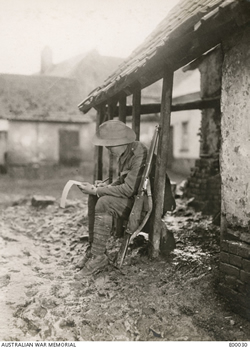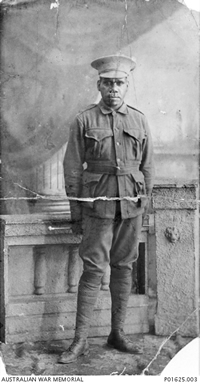Visual arts Stage 4
Overview

A member of the Australian 2nd Battalion 'carrying on' with his correspondence at Flesselles, November 1916
©Public Domain (AWM E00030)
Students examine the works by Indigenous artist Tony Albert and consider the importance of the work in reclaiming a presence for Indigenous Australians in our national military history and collections. Students experiment with printmaking to create portraits of class members, layering text and stencilling to explore concepts related to ‘green skins’, inspired by Tony Albert’s work.
Teaching and learning activities

Studio portrait of William Joseph Punch, 1st Battalion
©Public Domain (AWM P01625.003)
Material and conceptual practice of artist Tony Albert
Artmaking – Practice
Students investigate a range of materials and artmaking techniques to create 2D and 4D works, exploring two key concepts:
-
Anzac voices
-
Indigenous voice
Artmaking – Conceptual Framework
-
Artist
-
Artwork
-
Audience
-
World
Artmaking – Frames
-
Subjective frame
-
Cultural frame
Students explore the subjective and cultural frames to create works in relation to the two artmaking focus areas:
-
Anzac voices
-
Indigenous voice
Critical and historical studies – Practice
Key practitioner: Tony Albert
Students investigate both the material practice (including actions, processes, material choices and technical decisions) and conceptual practice (including thematic choices, inspiration, intentions and subject matter) of Tony Albert.
Students investigate themes and issues related to two focus areas:
-
Anzac voices
-
Indigenous voice
Critical and historical studies – Conceptual framework
-
Artist
-
Artwork
-
Audience
-
World
Critical and historical studies – Frames
-
Subjective frame
-
Cultural frame
Students use the subjective and cultural frames to explore the relationships between artists, artworks, audience and the world.
Artmaking
Activity 1
-
Discuss the role of letters and diaries in documenting the voice of the ANZACs and their experiences of war.
-
Investigate ANZAC voices, with particular reference to the key quotes for each year of the war.
-
Select one of the key quotes from 1914–1918 as the starting point for a 2D work that layers text with imagery. 2D forms could include drawing, painting, photography, computer generated graphics or collage.
-
Use sections of text from the key quote to layer over the work, with attention to font choice, direction, size and placement.
Activity 2
-
Use GarageBand or Windows Movie Maker to create a 4D work, that includes a digital scan or photograph of the 2D work and layers student voice recordings of selected phrases from the text included in the 2D work. Manipulate dynamic qualities and texture (vocal) to experiment with the concept of ‘ghost voices’. This technique is an audio interpretation of the animation technique of onion skinning.
-
Use the Conceptual Framework to discuss interaction between the agencies of artwork, audience and world. Identify the voice represented in the student works.
-
Refer to the ANZAC voices site to discuss the missing voices of war – those that are not represented through the site.
Activity 3
-
Discuss Albert’s conceptual practice with reference to portraits in the Norforce Commission. Note the use silhouettes and colour to portray particular characters. This builds on the idea of unnamed ephemera attached to Aboriginal service men and women.
-
Identify the key aspects of Albert’s material practice in the work Greens Skins (Guyula, Manakgu, Flowers, Warrior, Wunungmurra, Cooper, Evans, Langdon, Wilton, Yunupingu, Hodgson, Gunamalmal, Satour, James, Kris, Wanambi, McPhee, Manmurulu, Martin) and discuss the importance of both image and text in the work.
-
Experiment with printmaking (screen prints or graffiti stencilling) to create portraits of class members, layering text and stencilling to explore concepts related to ‘green skins’, inspired by Tony Albert’s work.
Critical and historical studies
Background information
-
Over 400 Indigenous Australians fought in the First World War Australian War Memorial.
-
In 2010 the Australian War Memorial received an anonymous donation to commission an Indigenous artist to record the activities of the Regional Force Surveillance Unit (RFSU) North West Mobile Unit (NORFORCE).
-
In May 2012 Tony Albert became the Memorial's first Indigenous official war artist, the first deployed with NORFORCE and the first artist to cover the activities of the Australian Defence Force on Australian soil since the end of the Second World War. Albert was attached to NORFORCE and based at the units' Kangaroo Flats training facility outside Darwin. He observed and participated in the training activities of an intake of young recruits.
Source: Tony Albert: Norforce Commission (YouTube)
Activity 1
-
Watch Tony Albert: Norforce Commission published by the Australian War Memorial. In this mini-documentary, Aboriginal artist Tony Albert (Girramay language group) discusses ceremonial and cultural duties used in particular Aboriginal clan groups and language groups in relation to ‘skin names’. One of the skin names he identifies is ‘green skin’, used to describe a member of a community who is involved with the army. The term demonstrates the evolving nature of Aboriginal culture. Albert discusses its influence on his work as an artist commissioned by the Australian War Memorial and stationed in the Northern Territory as part of NORFORCE.
Activity 2
-
Albert often questions ‘the contemporary legacies of colonial oppression from an Indigenous Australian perspective’ in his practice. From Tony Albert: Projecting our future, Art Gallery of New South Wales.
-
View Albert’s work Greens Skins (Guyula, Manakgu, Flowers, Warrior, Wunungmurra, Cooper, Evans, Langdon, Wilton, Yunupingu, Hodgson, Gunamalmal, Satour, James, Kris, Wanambi, McPhee, Manmurulu, Martin). How does the work portray an Indigenous Australian perspective? Discuss the importance of the work in reclaiming a presence for Indigenous Australians in our national military history and collections.
-
View other works by Albert in the Norforce collection. Use the cultural frame to discuss connections between Greens Skins (Guyula, Manakgu, Flowers, Warrior, Wunungmurra, Cooper, Evans, Langdon, Wilton, Yunupingu, Hodgson, Gunamalmal, Satour, James, Kris, Wanambi, McPhee, Manmurulu, Martin) and works such as Green Skin (Gangurru Camouflage) and Unknown Soldier (Gangurru Camouflage).
Visual arts references and resources
ANZAC voices, Australian War Memorial
Indigenous Australian servicemen, Australian War Memorial,
Tony Albert: Norforce Commission, Australian War Memorial, published Feb 19, 2014
Greens Skins (Guyula, Manakgu, Flowers, Warrior, Wunungmurra, Cooper, Evans, Langdon, Wilton, Yunupingu, Hodgson, Gunamalmal, Satour, James, Kris, Wanambi, McPhee, Manmurulu, Martin) by Tony Albert, Australian War Memorial (2012–2013)
Tony Albert, selected works, Norforce collection (2012–2013) Australian War Memorial search result
‘Indigenous soldiers’ on the Perspectives tab in Experiences.
Learning concepts
These additional questions can be used for discussion or further investigations.
Challenge
Treated as equals whilst serving with the armed forces during the First World War, what challenges did Indigenous Australian servicemen face when they returned to civilian life?
Change
The term ‘green skin’ demonstrates the evolving nature of Aboriginal culture. How does the term influence Tony Albert’s work as an artist commissioned by the Australian War Memorial and stationed in the Northern Territory as part of NORFORCE?
Community
How does Tony Albert’s work, Greens Skins (Guyula, Manakgu, Flowers, Warrior, Wunungmurra, Cooper, Evans, Langdon, Wilton, Yunupingu, Hodgson, Gunamalmal, Satour, James, Kris, Wanambi, McPhee, Manmurulu, Martin), portray an Indigenous Australian perspective? How does it reclaim a presence for Indigenous Australians in our national military history and collections?
Syllabus links
Artmaking
4.2 explores the function of and relationships between the artist – artwork – world – audience
4.3 makes artworks that involve some understanding of the frames
4.4 recognises and uses aspects of the world as a source of ideas, concepts and subject matter in the visual arts
4.5 investigates ways to develop meaning in their artworks
Critical and historical studies
4.7 explores aspects of practice in critical and historical interpretations of art
4.8 explores the function of and relationships between artist – artwork – world – audience
4.9 begins to acknowledge that art can be interpreted from different points of view
4.10 recognises that art criticism and art history construct meanings Artmaking
4.2 explores the function of and relationships between the artist – artwork – world – audience
4.3 makes artworks that involve some understanding of the frames
4.4 recognises and uses aspects of the world as a source of ideas, concepts and subject matter in the visual arts
4.5 investigates ways to develop meaning in their artworks
Critical and historical studies
4.7 explores aspects of practice in critical and historical interpretations of art
4.8 explores the function of and relationships between artist – artwork – world – audience
4.9 begins to acknowledge that art can be interpreted from different points of view
4.10 recognises that art criticism and art history construct meanings Artmaking
4.2 explores the function of and relationships between the artist – artwork – world – audience
4.3 makes artworks that involve some understanding of the frames
4.4 recognises and uses aspects of the world as a source of ideas, concepts and subject matter in the visual arts
4.5 investigates ways to develop meaning in their artworks
Critical and historical studies
4.7 explores aspects of practice in critical and historical interpretations of art
4.8 explores the function of and relationships between artist – artwork – world – audience
4.9 begins to acknowledge that art can be interpreted from different points of view
4.10 recognises that art criticism and art history construct meanings